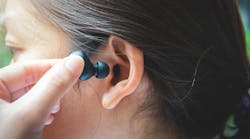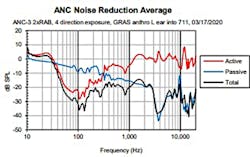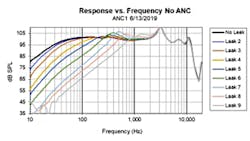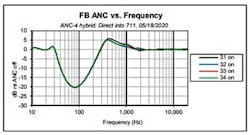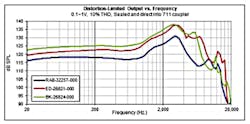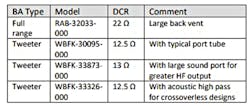Members can download this article in PDF format.
What you’ll learn:
- Design considerations specific to working with balanced armatures.
- How to approach ANC filtering when using BAs.
- What to consider when taking a hybrid approach with BAs and dynamic drivers.
As True Wireless Stereo (TWS) earphones become more mainstream, the consumer demands increasingly higher performance and more features, including active noise cancellation (ANC), higher-quality sound, longer battery life, and quick charging.
Balanced-armature (BA) drivers bring improved fidelity and detail over traditional dynamic drivers. BA drivers use an electronic signal to vibrate a tiny reed that’s balanced between two magnets inside a tiny enclosure. The motion of the reed is transferred to a very stiff aluminum diaphragm. This diaphragm is free of unwanted resonances in the audio band, allowing it to produce maximum clarity. The high-frequency response from BAs contributes to the loud and clear audio we hear in our on-ear monitors and hearing aids, for example.
Just as sound quality is important, premium features also are making their way into TWS earphones. One of these features is ANC, which is gaining in popularity. Before COVID-19, its growth stemmed from people using it for commuting or travel. In the last year, growth was driven by people spending more time working from home and wanting a quiet, focused space.
Many headphone and hearable designers use dynamic drivers to design ANC devices. However, a BA driver also can be combined with an existing dynamic speaker in what’s commonly called a hybrid earphone. In this configuration, BA drivers focus on the critical high-end portion of the audio spectrum, bringing a new level of clarity and realism.
BAs have many technical benefits beyond just sound quality. They’re smaller than other drivers, incredibly lightweight, and provide greater output with less power. Due to their incredibly small size, BAs leave more room for other components or a larger battery inside hearable devices and can allow multiple drivers to be combined to get the best sound and performance from TWS earphones.
This article presents a design guide for creating ANC earphones and hearables with balanced armatures. Modern TWS devices on the market tend to incorporate complex hardware and there’s always room for improvement. Herein, we highlight how one can increase the quality of hearables without compromising the audio quality.
The first portion will discuss ANC headset designs using only BA drivers. With this design guide as reference, it’s possible to create a competitive ANC system with BAs (Fig. 1). The second portion will discuss designing ANC headsets using a hybrid approach with a dynamic driver woofer and a balanced-armature tweeter. With proper crossover design, the ANC performance can be enhanced by adding the tweeter.
BA-Specific Design Considerations
An ANC headset using only a BA driver can deliver noise-reduction performance comparable to one using a dynamic driver, provided certain adjustments are made. Concerns about BA phase response have proven to be unwarranted. The BA driver can even provide better passive noise reduction than a dynamic driver.
Recommended adjustments include a reduction of the vent corner frequency, adding more low-frequency boost, and a stronger 3-kHz notch to the loop filter. One also may choose to add a level compressor to make the BA output seem even louder.
About Venting
A vent path from the ear canal to the outside world reduces the level of very-low-frequency occluded sounds (jaw motion/walking) and reduces the impact of leaks on ANC performance. However, just as a vent reduces occluded sounds, it also reduces the level of bass in music playback. The attenuated bass response can be compensated for by using corresponding electronic boost, but the maximum level of bass output from the driver is still reduced by the vent.
Vent size can be described by the corner frequency at which sound-pressure level (SPL) in the measurement coupler is reduced by 3 dB (Fig. 2). One may use vents with a higher cutoff frequency with drivers having higher maximum output capability. When a small BA driver covers low frequencies, a somewhat smaller vent enables a good balance of noise reduction and bass reproduction. We recommend a corner frequency in the range of 40 to 100 Hz.
ANC Filter Design Requirements for BAs
A hybrid ANC system requires three filters: a feedback (FB) filter, a feedforward (FF) filter, and a music ANC-compensation filter. The music-filter requirements are the same for dynamic and BA drivers.
The transfer functions of the driver, both in terms of sensitivity and phase, are critical to the performance of the ANC system. Designers accustomed to working with dynamic drivers have been concerned that sensitivity and phase curves for BAs look different than for dynamic drivers.
We have carefully studied these differences and found that this should not be cause for concern. The reason is that both dynamic and BA drivers are minimum-phase-shift devices in the frequency range needed for ANC. Thus, both classes of drivers produce the minimum amount of phase shift theoretically possible given their sensitivities.
When one applies a minimum-phase type of equalizer to flatten the response curves, the phase curves also become flat throughout the ANC frequency band. Due to their minimum phase-shift properties, any gain and phase response achieved with a dynamic driver can always be matched when using a BA driver after applying a suitable adjustment of the associated feedforward or feedback filter. Once the gain of the BA driver is adjusted to meet the open-loop filter target response, the open-loop phase will look nearly the same as it would have for a dynamic driver.
Passive Attenuation
The backside of the headphone driver is typically vented to the outside world. As a result, the driver’s diaphragm can move more freely, increasing the bass output to the ear. However, this also provides a path for outside sound to enter the ear. A BA driver provides more passive attenuation of the sound due to its higher mechanical stiffness. This slightly reduces the amount of active noise cancelling needed above the vent cutoff frequency.
Applying a Peak-Level Compressor
While BA drivers offer very high efficiency for their size, small-sized BA drivers will have a lower maximum output rating than a 6-mm or larger dynamic driver. This doesn’t keep them from being effective in ANC in most situations, but it could result in sounds of distress when short-term peaks occur.
One very effective solution for this issue is to use a peak compressor. It will limit the signal level sent to the speaker when there are loud sounds. The technique is widely used with portable Bluetooth speakers to give the illusion that they’re bigger than they really are. The audibility of the limiting can be minimized by using a fast attack time (<50 ms), a quick release time (0.25 to 1 s), and a steep compression ratio (>5:1).The peak limiter can be placed in different points in the signal chain. The placement may be limited by the flexibility of the device that’s performing the ANC computation. The simplest method is to place the limiter after all signals have been combined, just ahead of the digital-to-analog conversion. This assures that the combined music, FB, and FF paths don’t exceed a preset limit.
No matter how the earphone is used and what sounds occur in the environment, the BA speaker will be protected and will not produce any sounds of distress. If there’s an excessively loud sound, the amount of noise reduction will be momentarily reduced. Full ANC will be restored as soon as the peak passes.
A potential limitation of this arrangement is that any one of the signals will change the performance of the others. For example, bumping the earphone will cause a large FB signal, resulting in the music level being momentarily reduced.
While peaks can occur in any of the FB, FF, and music paths, the FB path is the one most likely to have large peaks. Therefore, it may be useful to place the peak limiter solely in the FB path. This will assure that the FF and music performance will not be adversely affected by any infrasound occurring within the ear canal. The choice of limiter location depends on the expected signal levels for the various signal paths.
Multi-Driver ANC
Hybrids employ a dynamic-driver woofer and BA tweeter to leverage the advantages of both. Dynamics typically have ample low-frequency output. BA tweeters provide high-frequency extension, high dynamic range, and excellent detail.
When a BA covers the treble range, the dynamic driver may potentially be smaller and tuned for optimal low-frequency performance. It also provides the designer more freedom in placing or angling the woofer relative to the ear-tip exit of the housing. Moreover, one can design a multi-way system using a large BA driver as the woofer, and a smaller BA as the tweeter.
When designed properly, adding a second driver doesn’t interfere with the ANC system. The key factor is to minimize phase lag in the woofer channel. This is done by using a low-order filter design for the woofer. Phase lag in the tweeter channel is much less important because it typically occurs above the frequency range in which the ANC system is active.
In any multi-way earphone, a crossover network divides energy to appropriate drivers. Excellent performance can be obtained even without a low-pass filter on the woofer (or a simple acoustic filter) and a single capacitor acting as high-pass filter on the tweeter. An active crossover also is possible in TWS earphones by using both outputs from the digital signal processor (DSP) to drive the woofer and tweeter separately. In either case, it’s possible to design the crossover to be compatible with ANC.
We studied a wide variety of crossover designs using simulations and confirmed them with measurements. These experiments yielded some valuable observations:
- Zero or first-order low-pass woofer filtering works best for stability.
- A crossover frequency of 4 kHz or higher works well for stability and audio performance.
- Tweeter filter order isn’t critical.
Figure 3 shows the amount of noise reduction. Figure 4 compares the music playback response with ANC turned off.
Higher-order woofer filters cause excessive phase shift, which degrades stability. Figure 5 shows the same earphone using a third-order filter. The ANC system experiences net gain instead of attenuation from 300 Hz to 1.5 kHz.
Recommended BA Models for ANC
If using a BA for low frequencies, it’s helpful to select a back-vented design. This provides low-frequency extension almost to dc and reduces low-frequency distortion. In addition, larger BA models will provide greater output, enabling proper cancellation of louder noises, and/or lower-resistance headset venting.
Because they have reduced output near 200 Hz, which is useful for avoiding muddy bass, resistive back vents are popular for wired headphones. However, for ANC applications, it’s helpful to use a non-resistive vent to maximize the output near 200 Hz. Then, electrical equalization is applied to reduce music bass output near 200 Hz, improving timbre and system headroom.
When selecting a tweeter, one with a larger sound port can reduce the inertance of the device, boosting output at very high frequencies. If the system doesn’t have room for an electrical crossover, there’s a model with an acoustical crossover available.
Acoustic engineers working on TWS solutions should take advantage of the small size, low power, and premium sound that balanced armatures offer for ANC earphones. Figure 6 shows maximum output vs. frequency for 10% total harmonic distortion (THD) for three of Knowles’ BA families, while the table provides recommendations for various ANC applications.
Summary
Those experienced in designing ANC earphones with dynamic speakers will find that with the help of this guide, only small changes are needed to adopt a pure BA or hybrid configuration. Remember that the BA should be selected to meet the maximum output requirements. The front vent should be chosen for an appropriate tradeoff between occlusion reduction, user variations, and low-frequency output requirements. The feedback-loop filter should be adjusted to reduce phase shift at the low- and high-frequency extremes of the ANC range.
At low frequencies, a second-order shelving filter boost may help to reduce the phase shift. At high frequencies, a notch filter matching the mechanical resonance of the driver is needed. If designing a system with a woofer and a tweeter, use a low-order filter—or none at all—for the woofer to avoid excess phase shift.
